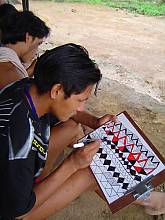
- Oral and graphic expressions of the Wajapi
- © Dominique Tilkin Gallois
Brazilian experiences in inventory-making go back to the creation in the 1930s of the Institute of Historic and Artistic Heritage (IPHAN) and the application of an administrative act called Tombamento for the legal protection of cultural heritage, both movable and immovable. The Tombamento was based on Western notions of authenticity, including preservation of property as much as possible in its original form, focusing on objects rather than on related social processes. When, in the 1970s, the concept of cultural heritage was broadened to include explicitly intangible assets, it became obvious that living cultural assets were to be safeguarded through specially adapted means, which eventually led to the creation by decree of the Registry of Intangible Cultural Assets in 2000.
Through this Registry intangible cultural heritage items are documented and publicized, in a way that takes into account the collective and individual rights linked to that heritage. Considering the dynamic nature of intangible cultural heritage, the Registry must be periodically revised, at least once every ten years. The registered properties are declared ‘Brazilian Cultural Heritage’, which entitles them to be promoted and to receive financial support for safeguarding plans. Parallel to the Registry, a National Programme for Intangible Heritage was established for preserving the country’s ethnic and cultural diversity, which included the National Inventory of Cultural References. For this National Inventory, an inventory-making methodology was prepared by IPHAN aimed at the identification of cultural assets, both tangible and intangible. Intangible cultural assets are divided into four categories: ‘Celebrations’, ‘Forms of expression’, ‘Craftsmanship or traditional knowledge’ and ‘Places or physical spaces’. The local delimitation of inventorying activities may correspond to a village, a district, a zone, an urban sector, a culturally differentiated geographic region or a complex of territories.
The inventory-making methodology comprises three phases:
(1) preliminary collection,
(2) identification and documentation, and
(3) interpretation.
The inventories carried out by IPHAN emphasize the cultural references of indigenous people, Afro-Brazilian citizens and groups inhabiting protected urban nuclei, as well as people living in multicultural urban contexts. There is a special focus on cultural properties at risk.
According to IPHAN, an important goal of inventorying intangible cultural heritage is to maintain the country’s cultural diversity in a context of homogenizing tendencies, and to contribute through the implementation of safeguarding mechanisms to social inclusion and improvement of living conditions of the tradition bearers. Since 2000, IPHAN has concluded 48 inventories of cultural references throughout the country and other 47 are now in progress. Sixteen cultural assets have been registered since 2002 and eleven action plans are being implemented in order to guarantee their transmission and continuity.